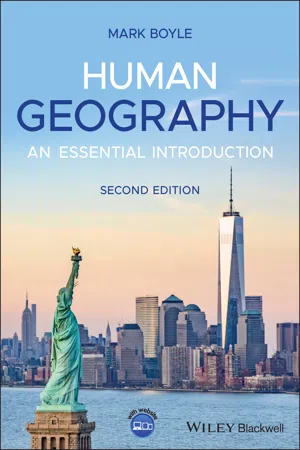
- English
- ePUB (mobile friendly)
- Available on iOS & Android
About this book
Revised, Extended, and Extensively Updated Text Uses Historical Geographical and Thematic Approach to Provide Undergraduates with a Firm Foundation in Human Geography
Drawing on nearly three decades of instructional experience and a wealth of testing pedagogical innovations with students, Mark Boyle has revised and expanded this authoritative and comprehensive introduction to Human Geography. As with the First Edition, Boyle follows the premise that "history makes geography whilst geography makes history," and that the key to studying the principal demographic, social, political, economic, cultural and environmental processes in any region in the world today is to look at how that region has been impacted by, and in turn has impacted, the story of the rise, reign, and decline of the West. Moreover he argues that Human Geography itself is best understood as both an intellectual endeavour and a historical, political, and institutional project.
Informed by recent developments in post-colonial scholarship, the book covers key concepts, seminal thinkers, and influential texts in the field. Although designed for the beginner student, Boyle does not shy away from ideas and debates often avoided in introductory texts, clearly communicating theory without condescension. In addition, he places human geography in its larger academic context, discussing the influences on the field from related subjects. Notable features in the Second Edition include:
- Extensive revision and updating of coverage of key ideas, developments, debates and case studies
- New chapter on uneven geographical development at different scales and development theory and practice
- Dedicated coverage of Covid-19s geographies
- New learning resources (figures, tables, plates, maps, Deep Dive boxes, etc.) throughout the text, plus learning objectives, essay questions, checklists summarizing key ideas, and guidance for further reading
- Updated and expanded companion website with MP4 and MP3 chapter-by-chapter lectures and PowerPoint slides for each chapter, new multiple-choice exam paper and additional essay-style exam questions, and a wide range of student tutorial exercises
Human Geography: An Essential Introduction, Second Edition is an excellent foundational text for undergraduate courses in human geography, globalization, Western civilization, historiographies of intellectual thought, the grand public problems confronting humanity in the twenty first century, and other wider social science courses.
Frequently asked questions
- Essential is ideal for learners and professionals who enjoy exploring a wide range of subjects. Access the Essential Library with 800,000+ trusted titles and best-sellers across business, personal growth, and the humanities. Includes unlimited reading time and Standard Read Aloud voice.
- Complete: Perfect for advanced learners and researchers needing full, unrestricted access. Unlock 1.4M+ books across hundreds of subjects, including academic and specialized titles. The Complete Plan also includes advanced features like Premium Read Aloud and Research Assistant.
Please note we cannot support devices running on iOS 13 and Android 7 or earlier. Learn more about using the app.
Information
Chapter 1
Introducing Human Geography
Chapter Learning Objectives
- Attain a heightened awareness of your geographical imagination and recognise the value of improving it through formal education.
- Provide a working definition of human geography, and identify the three central concerns of human geography.
- Appreciate the importance of the ascent of the West from the fifteenth century, its global dominance across a subsequent 500‐year period, and its recent crisis in confidence, in the making of the contemporary world.
- Identify and comment upon the merits of four overarching theories human geographers use to explain the rise, reign, and faltering of the West from the fifteenth century.
Introduction
What Is Human Geography?
Deep Dive Box 1.1 Awaken Your Geographical Imagination! Around the World in Eighty Days (Or Even Eighty Hours?)
Table of contents
- Cover
- Table of Contents
- About the Companion Website
- Title Page
- Copyright Page
- Dedication Page
- List of Figures
- List of Plates
- List of Maps
- List of Tables
- Acknowledgments
- List of Abbreviations
- A Guide to Reading the Second Edition of Human Geography: An Essential Introduction
- Chapter 1: Introducing Human Geography
- Chapter 2: Human Geography
- Chapter 3: Big History
- Chapter 4: The Commanding Heights
- Chapter 5: Power
- Chapter 6: Worlds of Meaning
- Chapter 7: (Under)Development
- Chapter 8: 10 000 000 000
- Chapter 9: A Planet in Distress
- Chapter 10: Homo urbanus
- Chapter 11: The Walling of the West
- Chapter 12: At Risk
- Chapter 13: Remaking the West, Remaking Human Geography
- Coda on Covid‐19
- Glossary
- Index
- End User License Agreement